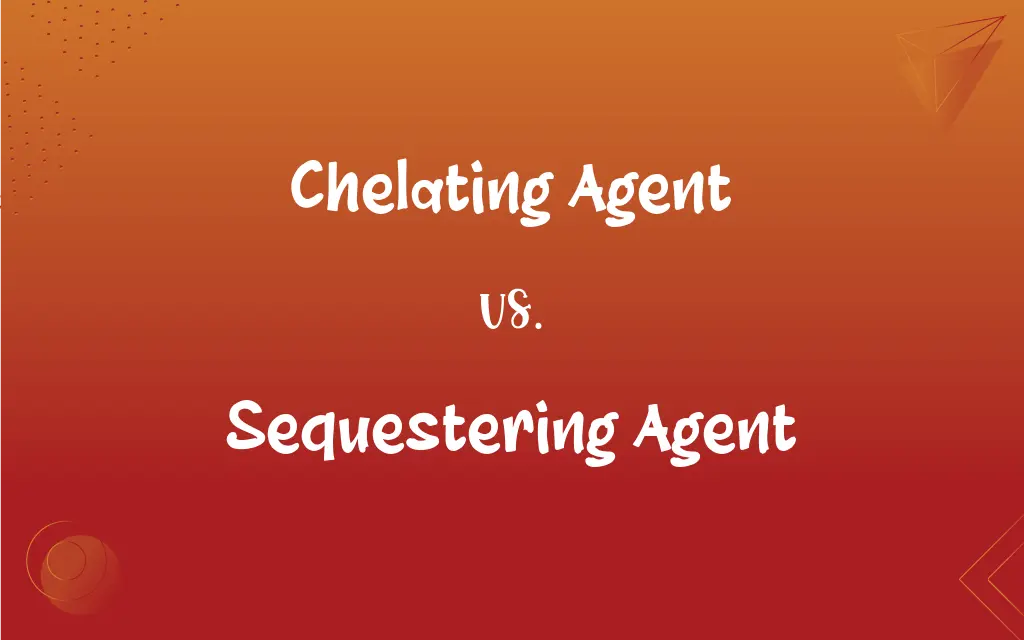Chelating Agent vs. Sequestering Agent: What's the Difference?
Edited by Aimie Carlson || By Janet White || Published on January 9, 2024
A chelating agent forms multiple bonds with a single metal ion, while a sequestering agent traps and holds particles, often including ions, without forming strong bonds.

Key Differences
Chelating agents bind to metal ions using multiple sites, forming stable complexes. Sequestering agents, on the other hand, isolate or trap ions or molecules without necessarily forming such complexes.
Chelating agents are often used to deactivate metal ions in a process, while sequestering agents are used to prevent undesired reactions by isolating reactive particles.
The action of a chelating agent is like 'grabbing' and stabilizing metal ions, whereas a sequestering agent 'encapsulates' or entraps particles, reducing their reactivity.
Chelating agents are crucial in applications like metal detoxification, whereas sequestering agents are used in applications like water softening and detergents.
Examples of chelating agents include EDTA, which forms strong complexes with metals, while examples of sequestering agents include polyphosphates used in detergents.
ADVERTISEMENT
Comparison Chart
Bond Formation
Forms multiple bonds with a single ion
Traps particles without strong bonding
Primary Function
Deactivate metal ions by complex formation
Isolate/reactive particles to prevent reactions
Mechanism
'Grabs' ions, stabilizing them
'Encapsulates' particles, reducing reactivity
Applications
Metal detoxification, medicine
Water softening, detergents
Example
EDTA with heavy metals
Polyphosphates in laundry detergents
ADVERTISEMENT
Chelating Agent and Sequestering Agent Definitions
Chelating Agent
A substance that forms stable complexes with metal ions.
EDTA is a chelating agent used to treat lead poisoning.
Sequestering Agent
Often used in cleaning products and water treatment.
Sequestering agents in soaps prevent soap scum formation.
Chelating Agent
Used in detoxifying heavy metals from the body.
Chelation therapy employs a chelating agent to remove toxins.
Sequestering Agent
A compound that isolates ions or molecules.
The sequestering agent in the detergent prevents mineral deposits.
Chelating Agent
Forms multiple coordination bonds with a single metal ion.
This chelating agent is effective in binding copper ions.
Sequestering Agent
Prevents undesired reactions by trapping reactive species.
The sequestering agent in the solution inhibits corrosion.
Chelating Agent
Often contains nitrogen and oxygen donor atoms.
The chelating agent in this formula stabilizes metal nutrients.
Sequestering Agent
Used to control metal ions in solutions.
This sequestering agent binds calcium to soften water.
Chelating Agent
Binds to metals to deactivate them.
The chelating agent removed excess iron from the solution.
Sequestering Agent
Can bind or encapsulate without strong chemical bonding.
The sequestering agent is used to stabilize the chemical mixture.
FAQs
How do chelating agents work with metals?
By binding and stabilizing them.
Can chelating agents be used in medicine?
Yes, in treatments like metal detoxification.
Are sequestering agents used in detergents?
Yes, to prevent mineral deposits.
What is the primary use of a sequestering agent?
To trap and isolate particles or ions.
Can sequestering agents soften water?
Yes, by binding calcium and magnesium.
Is EDTA a common chelating agent?
Yes, it's widely used for heavy metals.
What is the main role of a chelating agent?
To form stable complexes with metal ions.
Do sequestering agents form strong bonds?
No, they encapsulate without strong bonding.
Are chelating agents biodegradable?
It varies; some are, others aren't.
Can sequestering agents be natural?
Yes, some are derived from natural sources.
Are chelating agents specific to certain metals?
Yes, they can be specific to particular metal ions.
Do sequestering agents prevent corrosion?
Yes, by isolating reactive metal ions.
Can chelating agents be used in food processing?
Yes, for stabilizing certain minerals.
Are all chelating agents synthetic?
No, some are naturally occurring.
Are sequestering agents safe for all applications?
Their safety depends on the specific use and agent.
Can sequestering agents improve soap performance?
Yes, by preventing soap scum.
How do chelating agents affect metal absorption in the body?
They can enhance or inhibit it.
Are sequestering agents harmful to the environment?
Depends on the agent; some can be.
How are chelating agents used in agriculture?
To stabilize nutrients in fertilizers.
Do sequestering agents affect pH levels?
They can, depending on their nature.
About Author
Written by
Janet WhiteJanet White has been an esteemed writer and blogger for Difference Wiki. Holding a Master's degree in Science and Medical Journalism from the prestigious Boston University, she has consistently demonstrated her expertise and passion for her field. When she's not immersed in her work, Janet relishes her time exercising, delving into a good book, and cherishing moments with friends and family.
Edited by
Aimie CarlsonAimie Carlson, holding a master's degree in English literature, is a fervent English language enthusiast. She lends her writing talents to Difference Wiki, a prominent website that specializes in comparisons, offering readers insightful analyses that both captivate and inform.






































































